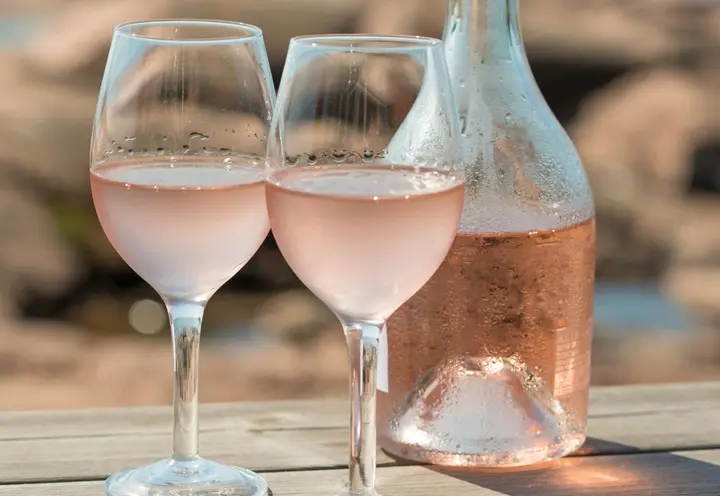Rosé champagne, often associated with elegance and celebration, presents a unique sensory experience that combines the richness of champagne with the delicate nuances of red fruits. This article aims to explore what makes rosé champagne distinct, from its production methods to its tasting notes and ideal pairings.
Rosé champagne, with its beautiful pink hue, stands apart from traditional white champagnes not only in appearance but also in taste. Unlike its counterparts, which derive their color solely from white grapes, rosé champagne acquires its blush from the inclusion of red grapes during the winemaking process. This blending technique or limited skin contact imparts both color and additional flavors, setting it apart as a versatile and intriguing option for wine enthusiasts.
Production Methods
Saignée Method
One of the methods used to produce rosé champagne is the saignée method, which translates from French as “bleeding.” In this technique, red grapes are gently pressed, allowing some of the grape juice to run off after a brief period of contact with the grape skins. This method not only extracts color but also introduces tannins and deeper fruity flavors to the champagne.
Blending Method
Another widely employed method is blending, where a small amount of still red wine is added to the base cuvée of champagne. This approach provides winemakers with precise control over the final color and flavor profile of the champagne, ensuring consistency and quality across different vintages.
Tasting Notes
Appearance
Rosé champagne typically exhibits a range of pink hues, from pale salmon to deep ruby, depending on the grape varieties used and the winemaking techniques employed. The color intensity can hint at the wine’s age and style, with younger rosés often displaying brighter pink tones and older ones showcasing more developed coppery hues.
Aromas
The aromas of rosé champagne are a delightful blend of fresh red berries such as strawberries, raspberries, and cherries, intertwined with floral notes like rose petals and sometimes hints of citrus zest. These fragrances contribute to the wine’s allure and make it a sensory delight even before the first sip.
Palate
Upon tasting, rosé champagne reveals a harmonious balance of crisp acidity and subtle sweetness, with flavors that echo its aromatic profile. The red fruit notes persist, accompanied by nuances of baked bread or brioche, a hallmark of champagne’s secondary fermentation in the bottle. The texture is often creamy yet refreshing, offering a velvety mouthfeel that enhances the overall drinking experience.
Finish
The finish of rosé champagne is characterized by its persistence and finesse. It lingers on the palate with a gentle minerality and a hint of tartness, leaving a lasting impression that invites another sip. The length of the finish can vary depending on the champagne’s quality and aging, with older rosés often exhibiting more complex and nuanced flavors that evolve gracefully over time.
See Also: Champagne Ayala and Piper Heidsieck Release Notable 2018 Vintages
Pairing Rosé Champagne
Food Pairings
Rosé champagne’s versatility extends to its ability to complement a wide range of foods. Its vibrant acidity and fruity character make it an excellent match for seafood such as oysters, sushi, or grilled shrimp. The effervescence and slight sweetness of rosé champagne also pair beautifully with creamy cheeses like Brie or Camembert, balancing their richness with refreshing bubbles.
Occasions
Rosé champagne is synonymous with celebration and romance, making it a popular choice for special occasions such as weddings, anniversaries, or simply a romantic dinner for two. Its elegant appearance and nuanced flavors elevate any event, whether enjoyed as an apéritif or paired with a multi-course meal.
Popular Rosé Champagne Brands
Moët & Chandon Rosé Impérial
Moët & Chandon, a renowned champagne house, produces a delightful rosé champagne known as Rosé Impérial. It blends Pinot Noir, Pinot Meunier, and Chardonnay grapes to achieve a well-balanced profile of red fruits and floral notes, making it a favorite among champagne enthusiasts worldwide.
Veuve Clicquot Rosé
Veuve Clicquot’s Rosé champagne is another iconic choice, recognized for its rich color and complex flavors. It combines the intensity of Pinot Noir with the freshness of Chardonnay and Pinot Meunier, resulting in a champagne that is both lively and refined, ideal for special occasions or casual gatherings alike.
Dom Pérignon Rosé
For those seeking a more luxurious experience, Dom Pérignon offers a prestigious rosé champagne that embodies elegance and sophistication. Crafted from the finest grapes in Champagne, this champagne is aged to perfection, showcasing layers of red fruit, spice, and minerality that culminate in a truly exceptional tasting experience.
Conclusion
Rosé champagne represents the epitome of elegance and refinement in the world of sparkling wines. Its unique production methods, ranging from saignée to blending, impart distinct flavors and aromas that captivate the senses. Whether enjoyed on its own or paired with food, rosé champagne offers a sensory journey characterized by vibrant red fruit notes, delicate floral aromatics, and a crisp, refreshing finish. From casual celebrations to formal affairs, rosé champagne remains a timeless choice that continues to enchant and delight wine enthusiasts around the globe. Cheers to the joyous moments and exquisite flavors that rosé champagne brings to every occasion.


